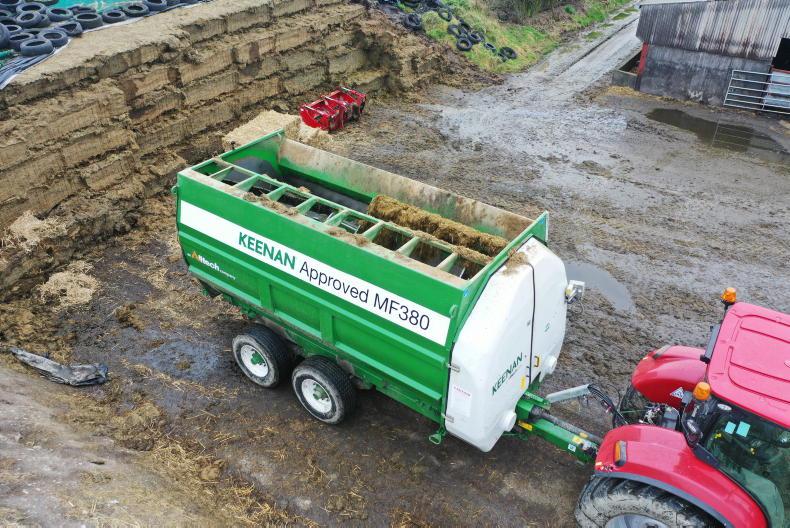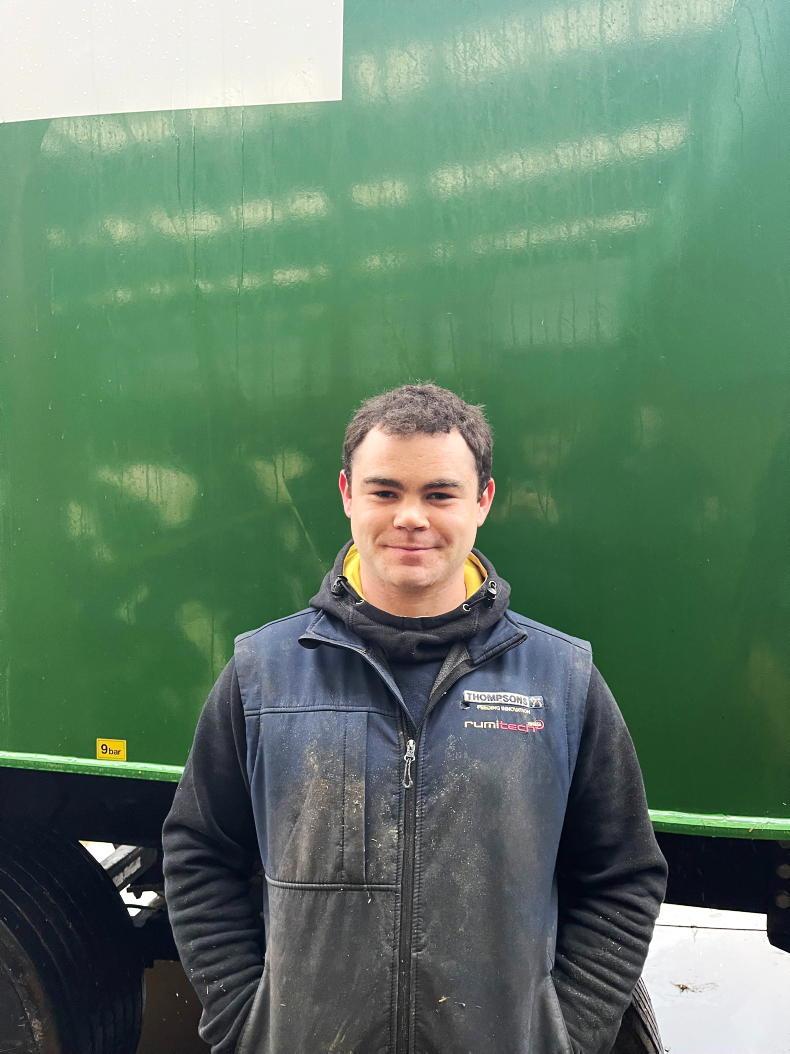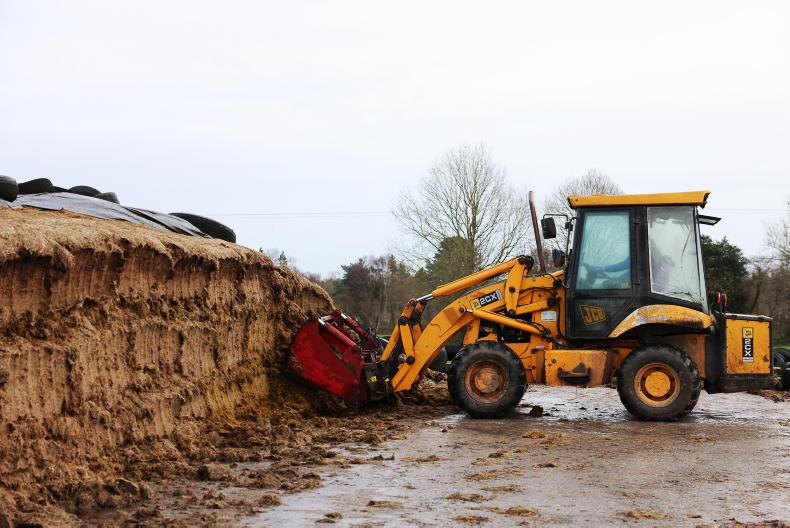Will I go for a paddle or a vertical diet feeder? This is the age-old question many farmers who use or have considered going down the route of using a diet feeder have asked themselves at some stage over the years.
Different manufacturers claim the benefits of both systems, and there are many farmers out there who have tried and successfully used both methods. Many manufacturers have started and stopped production of both systems. At present, there is more of a tendency among Irish manufacturers to offer vertical machines than paddle machines.
To put it into context, the only companies who currently offer paddle machines are Keenan and Redrock. Both of these companies also offer vertical machines, as do others such as HiSpec, Abbey, Conor and FeedAll. If we look at the international market, the manufacturing of vertical machines is also more popular.
We recently caught up with two dairy farmers and avid diet feeder users in Meath and Down to find out why they have stuck with their respective mixing systems over the years.

A vertical machine is designed to mix material by pulling it downwards as the auger rotates.
Keenan
To avoid putting two manufacturers head-to-head, we took a look at a paddle and vertical machine being offered by the one manufacturer. Keenan would be traditionally known as being manufacturers and almost pioneers of the paddle design. However, they too began offering a vertical design. This came in 2017, through a partnership with Italian feeder manufacturer Storti, shortly after the company was taken over by Alltech. Despite offering both systems for the past five years now, Keenan claims that 90% of its sales today are paddle, and 10% vertical machines.
Paddle v vertical – the main differences
Both feeder concepts are capable of achieving the same result, but the mechanical process in how they do so differs significantly.
Vertical
Depending on cubic capacity, a vertical machine encompasses either one or two and on larger feeders up to three augers.
Each auger is fitted with a number of knives which together mix and chop the feed constituents. In theory, a vertical machine is designed to mix material by pushing it upwards as the auger rotates.
As with any machine, there are subtle differences between brands such as auger pitch and knife position but the principle remains the same across the board. 
The driveline represents a major difference between both feeder types.
As the name suggests, a vertical machine’s auger rotates on the vertical axis. Most vertical feeders use a two-speed gearbox to achieve the right ratio, and from there power is transferred through 90° gearboxes which rotate the auger(s).
The two-speed gearbox reduces the power requirement and rotational speed on the output (auger) side while increasing torque. On such two-speed gearboxes, the slower speed tends to be for the mixing of round bale silage. 
Most vertical feeders use a two-speed gearbox to achieve the right ratio, and from there power is transferred through 90-degree gearboxes which rotates the auger(s).
Vertical feeders tend to offer greater flexibility when it comes to feed discharge options.
Theoretically, feed can be discharged from left or right sides either at the front or the back.
There is also an option for front or rear conveyors or a rear ‘bomb’ door for the discharge of mixed feed such as concentrates to the rear of the machine. 
Vertical feeders tend to offer greater flexibility with feed discharge options, with feed able to be discharged from left or right sides either at the front or the back.
Paddle
A paddle feeder takes a completely different approach TO MIXING. Firstly, the paddle arrangement rotates through the horizontal axis with the knife configuration fixed to the body of the feeder. Here, a tumbling motion using staggered paddles with the aid of the discharge auger mixes feed constituents. The paddles essentially force the feed through the fixed knife arrangement. Once mixed, the discharge auger which runs across the length of the machine moves the feed mix to the discharge door to be fed out. 
A paddle feeder rotates through the horizontal axis and uses a tumbling motion with staggered paddles to mix feed constituents.
A benefit of a paddle machine is the even discharge of feed and its ability to empty itself completely as the paddles are fitted with sweeping rubbers.
Some will also strongly argue that the tumbling motion provides a more even mix of constituents, particularly the likes of concentrates and minerals.
That said, multiple discharge options on a paddle machine are limited. Unless fitted with a rear conveyor, feed discharge can theoretically only take place on one side of the machine given that its paddles are designed to turn in only one direction. 
The paddle arrangement rotates through the horizontal axis, with the knife configuration fixed to the body of the feeder.
Naturally, the driveline differs to a vertical feeder in that it remains horizontal and is therefore directly driven. A large chain and sprocket drive submersed in an oil bath replaces the sealed gearboxes of its vertical counterpart. 
A large chain and sprocket drive submersed in an oil bath replaces the sealed gearboxes of its vertical counterpart.
Historically, the general consensus among farmers was that a vertical feeder will mix and chop round bales of silage better, although most paddle feeder manufacturers market their machines as being perfectly capable of handling all lengths of forage. This has come to the forefront more so in recent years with the addition of extra knives to most paddle mixers.

Unless fitted with a conveyor, feed discharge can theoretically only take place on one side of a paddle machine as its paddles are designed to turn in only one direction.
Declan McGuinness,
Co Meath
Farming upwards of 400 cows on a grass-based system, the McGuinness family have years of experience using a paddle feeder on their farm. Declan upgraded his previous paddle diet feeder at the beginning of last season and stuck with the same system once again, but this time opted for a larger Keenan-approved Mechfiber 380, which is a 24m3 machine.
“We did price a tub machine when we made the decision to upgrade last year. However, all of our feed is dispensed from the diet feeder into bunker troughs. We felt if the flap on the paddle machine got a bang it wouldn’t be near as expensive to repair as an elevator conveyer would on a vertical machine. And to be honest, we probably feel that you get a better mix with a paddle machine over the vertical machine. The majority of our mixes include pit silage, straw, minerals and maybe some soya etc. We bought some big square bales of hay this year to stretch out our silage and the paddle machine handled them at its ease. We don’t use any round bales on the farm; all our silage goes into the pit.
“We use a Case IH Puma 150 to drive the 24-cube paddle feeder. The feeder when it’s loaded is 9-10t so you’d want a heavy tractor to handle it with comfort.” 
Declan McGuinness, Co Meath.
Henry McCracken,
Co Down
Farming on the Ards Peninsula in Co Down, Henry McCracken and his father Malcolm milk over 200 cows on a grass-based system along with a beef enterprise. The family have been using a diet feeder on the farm for over 20 years, and have always used vertical machines.
“We have always fed a lot of bale silage on our farm. We always felt the tub machine was the most suitable to handle bales from our own experience and from what we’ve seen around different yards so I suppose we just decided to stick with the tub machine. In 2019, we made the move over to Keenan and purchased a new VA2-21, 21m3 twin-auger machine. We drive the machine with a John Deere 6820. The machine uses a figure of eight type mixing system which we really like and pulls bales into it really well. We’ve found it very easy to drive, which we think is largely down to the fact that it’s geared very well. The John Deere handles it with ease.
“Typically, our mixes consist of grass, bale and or pit silage, whole crop, minerals and some blends. We find that a typical mix would take in the region of eight to ten minutes.”

Henry McCracken , Co Down.
Verdict
We feel the vertical feeder has a slight edge in terms of all round versatility. It’s better suited to a farm where space may be restricted and where multiple discharge options are required to feed to the left and right in different sheds. In a situation where silage tends to be predominately round bales, the majority of farmers we have spoken to on the ground would lean towards a vertical feeder as the system of choice.
Meanwhile, the paddle feeder works to its full potential where precision-chop silage, shorter forages and concentrates are the main feedstuffs. Most paddle users will argue that this system offers a more consistent mix, and a more consistent feed out.
However, unless fitted with a conveyor, discharge can theoretically only take place on one side of the machine with the paddles designed to turn in one direction. A paddle machine also has the ability to empty itself completely thanks to sweeping rubbers, while some tub machines have a tendency to retain feed on top of the auger’s flights.
However, both vertical and paddle feeders have a place in the market and this will remain the case. At the end of the day, it comes down to the farmer’s individual situation and personal preference.
Will I go for a paddle or a vertical diet feeder? This is the age-old question many farmers who use or have considered going down the route of using a diet feeder have asked themselves at some stage over the years.
Different manufacturers claim the benefits of both systems, and there are many farmers out there who have tried and successfully used both methods. Many manufacturers have started and stopped production of both systems. At present, there is more of a tendency among Irish manufacturers to offer vertical machines than paddle machines.
To put it into context, the only companies who currently offer paddle machines are Keenan and Redrock. Both of these companies also offer vertical machines, as do others such as HiSpec, Abbey, Conor and FeedAll. If we look at the international market, the manufacturing of vertical machines is also more popular.
We recently caught up with two dairy farmers and avid diet feeder users in Meath and Down to find out why they have stuck with their respective mixing systems over the years.

A vertical machine is designed to mix material by pulling it downwards as the auger rotates.
Keenan
To avoid putting two manufacturers head-to-head, we took a look at a paddle and vertical machine being offered by the one manufacturer. Keenan would be traditionally known as being manufacturers and almost pioneers of the paddle design. However, they too began offering a vertical design. This came in 2017, through a partnership with Italian feeder manufacturer Storti, shortly after the company was taken over by Alltech. Despite offering both systems for the past five years now, Keenan claims that 90% of its sales today are paddle, and 10% vertical machines.
Paddle v vertical – the main differences
Both feeder concepts are capable of achieving the same result, but the mechanical process in how they do so differs significantly.
Vertical
Depending on cubic capacity, a vertical machine encompasses either one or two and on larger feeders up to three augers.
Each auger is fitted with a number of knives which together mix and chop the feed constituents. In theory, a vertical machine is designed to mix material by pushing it upwards as the auger rotates.
As with any machine, there are subtle differences between brands such as auger pitch and knife position but the principle remains the same across the board. 
The driveline represents a major difference between both feeder types.
As the name suggests, a vertical machine’s auger rotates on the vertical axis. Most vertical feeders use a two-speed gearbox to achieve the right ratio, and from there power is transferred through 90° gearboxes which rotate the auger(s).
The two-speed gearbox reduces the power requirement and rotational speed on the output (auger) side while increasing torque. On such two-speed gearboxes, the slower speed tends to be for the mixing of round bale silage. 
Most vertical feeders use a two-speed gearbox to achieve the right ratio, and from there power is transferred through 90-degree gearboxes which rotates the auger(s).
Vertical feeders tend to offer greater flexibility when it comes to feed discharge options.
Theoretically, feed can be discharged from left or right sides either at the front or the back.
There is also an option for front or rear conveyors or a rear ‘bomb’ door for the discharge of mixed feed such as concentrates to the rear of the machine. 
Vertical feeders tend to offer greater flexibility with feed discharge options, with feed able to be discharged from left or right sides either at the front or the back.
Paddle
A paddle feeder takes a completely different approach TO MIXING. Firstly, the paddle arrangement rotates through the horizontal axis with the knife configuration fixed to the body of the feeder. Here, a tumbling motion using staggered paddles with the aid of the discharge auger mixes feed constituents. The paddles essentially force the feed through the fixed knife arrangement. Once mixed, the discharge auger which runs across the length of the machine moves the feed mix to the discharge door to be fed out. 
A paddle feeder rotates through the horizontal axis and uses a tumbling motion with staggered paddles to mix feed constituents.
A benefit of a paddle machine is the even discharge of feed and its ability to empty itself completely as the paddles are fitted with sweeping rubbers.
Some will also strongly argue that the tumbling motion provides a more even mix of constituents, particularly the likes of concentrates and minerals.
That said, multiple discharge options on a paddle machine are limited. Unless fitted with a rear conveyor, feed discharge can theoretically only take place on one side of the machine given that its paddles are designed to turn in only one direction. 
The paddle arrangement rotates through the horizontal axis, with the knife configuration fixed to the body of the feeder.
Naturally, the driveline differs to a vertical feeder in that it remains horizontal and is therefore directly driven. A large chain and sprocket drive submersed in an oil bath replaces the sealed gearboxes of its vertical counterpart. 
A large chain and sprocket drive submersed in an oil bath replaces the sealed gearboxes of its vertical counterpart.
Historically, the general consensus among farmers was that a vertical feeder will mix and chop round bales of silage better, although most paddle feeder manufacturers market their machines as being perfectly capable of handling all lengths of forage. This has come to the forefront more so in recent years with the addition of extra knives to most paddle mixers.

Unless fitted with a conveyor, feed discharge can theoretically only take place on one side of a paddle machine as its paddles are designed to turn in only one direction.
Declan McGuinness,
Co Meath
Farming upwards of 400 cows on a grass-based system, the McGuinness family have years of experience using a paddle feeder on their farm. Declan upgraded his previous paddle diet feeder at the beginning of last season and stuck with the same system once again, but this time opted for a larger Keenan-approved Mechfiber 380, which is a 24m3 machine.
“We did price a tub machine when we made the decision to upgrade last year. However, all of our feed is dispensed from the diet feeder into bunker troughs. We felt if the flap on the paddle machine got a bang it wouldn’t be near as expensive to repair as an elevator conveyer would on a vertical machine. And to be honest, we probably feel that you get a better mix with a paddle machine over the vertical machine. The majority of our mixes include pit silage, straw, minerals and maybe some soya etc. We bought some big square bales of hay this year to stretch out our silage and the paddle machine handled them at its ease. We don’t use any round bales on the farm; all our silage goes into the pit.
“We use a Case IH Puma 150 to drive the 24-cube paddle feeder. The feeder when it’s loaded is 9-10t so you’d want a heavy tractor to handle it with comfort.” 
Declan McGuinness, Co Meath.
Henry McCracken,
Co Down
Farming on the Ards Peninsula in Co Down, Henry McCracken and his father Malcolm milk over 200 cows on a grass-based system along with a beef enterprise. The family have been using a diet feeder on the farm for over 20 years, and have always used vertical machines.
“We have always fed a lot of bale silage on our farm. We always felt the tub machine was the most suitable to handle bales from our own experience and from what we’ve seen around different yards so I suppose we just decided to stick with the tub machine. In 2019, we made the move over to Keenan and purchased a new VA2-21, 21m3 twin-auger machine. We drive the machine with a John Deere 6820. The machine uses a figure of eight type mixing system which we really like and pulls bales into it really well. We’ve found it very easy to drive, which we think is largely down to the fact that it’s geared very well. The John Deere handles it with ease.
“Typically, our mixes consist of grass, bale and or pit silage, whole crop, minerals and some blends. We find that a typical mix would take in the region of eight to ten minutes.”

Henry McCracken , Co Down.
Verdict
We feel the vertical feeder has a slight edge in terms of all round versatility. It’s better suited to a farm where space may be restricted and where multiple discharge options are required to feed to the left and right in different sheds. In a situation where silage tends to be predominately round bales, the majority of farmers we have spoken to on the ground would lean towards a vertical feeder as the system of choice.
Meanwhile, the paddle feeder works to its full potential where precision-chop silage, shorter forages and concentrates are the main feedstuffs. Most paddle users will argue that this system offers a more consistent mix, and a more consistent feed out.
However, unless fitted with a conveyor, discharge can theoretically only take place on one side of the machine with the paddles designed to turn in one direction. A paddle machine also has the ability to empty itself completely thanks to sweeping rubbers, while some tub machines have a tendency to retain feed on top of the auger’s flights.
However, both vertical and paddle feeders have a place in the market and this will remain the case. At the end of the day, it comes down to the farmer’s individual situation and personal preference.



















SHARING OPTIONS